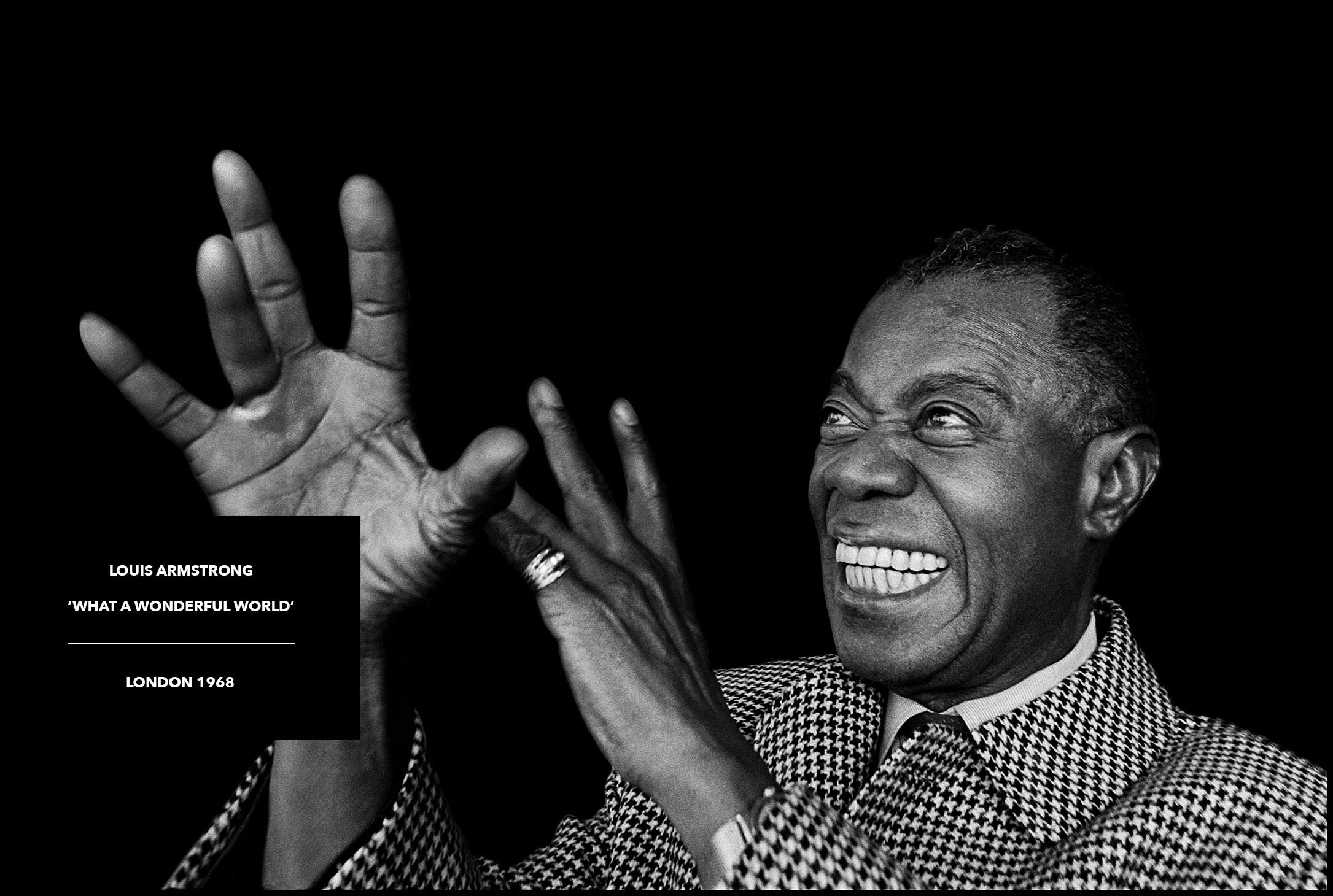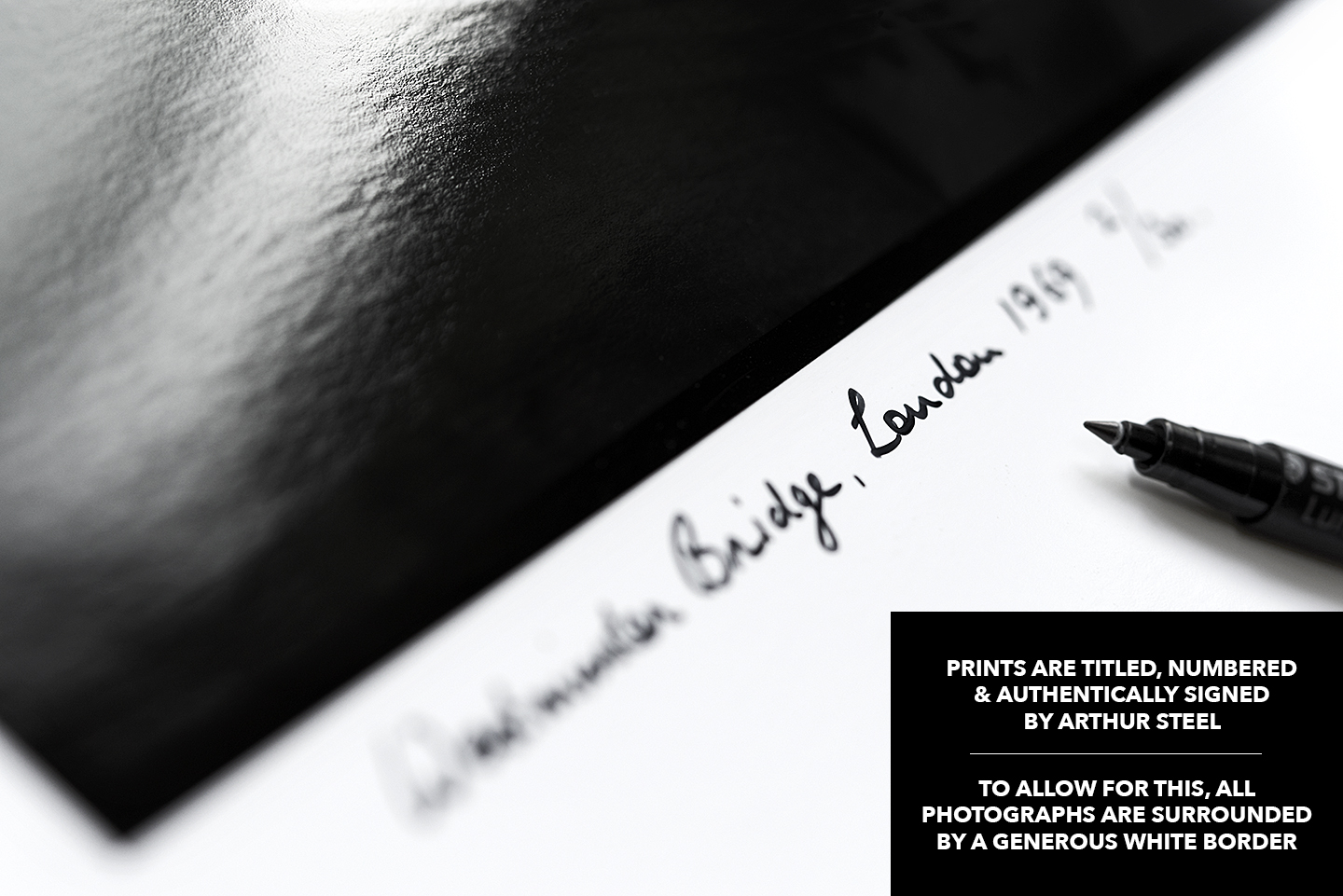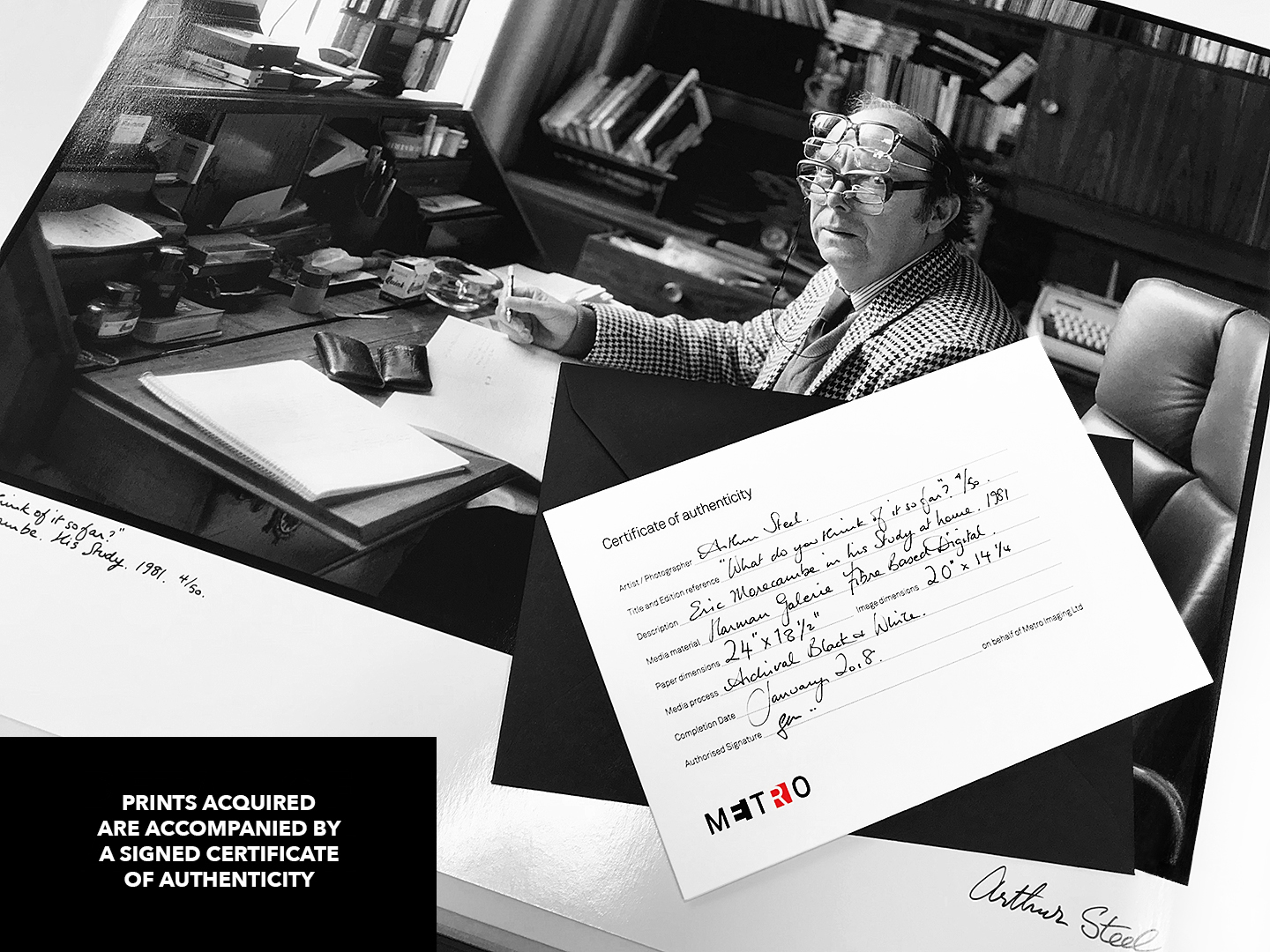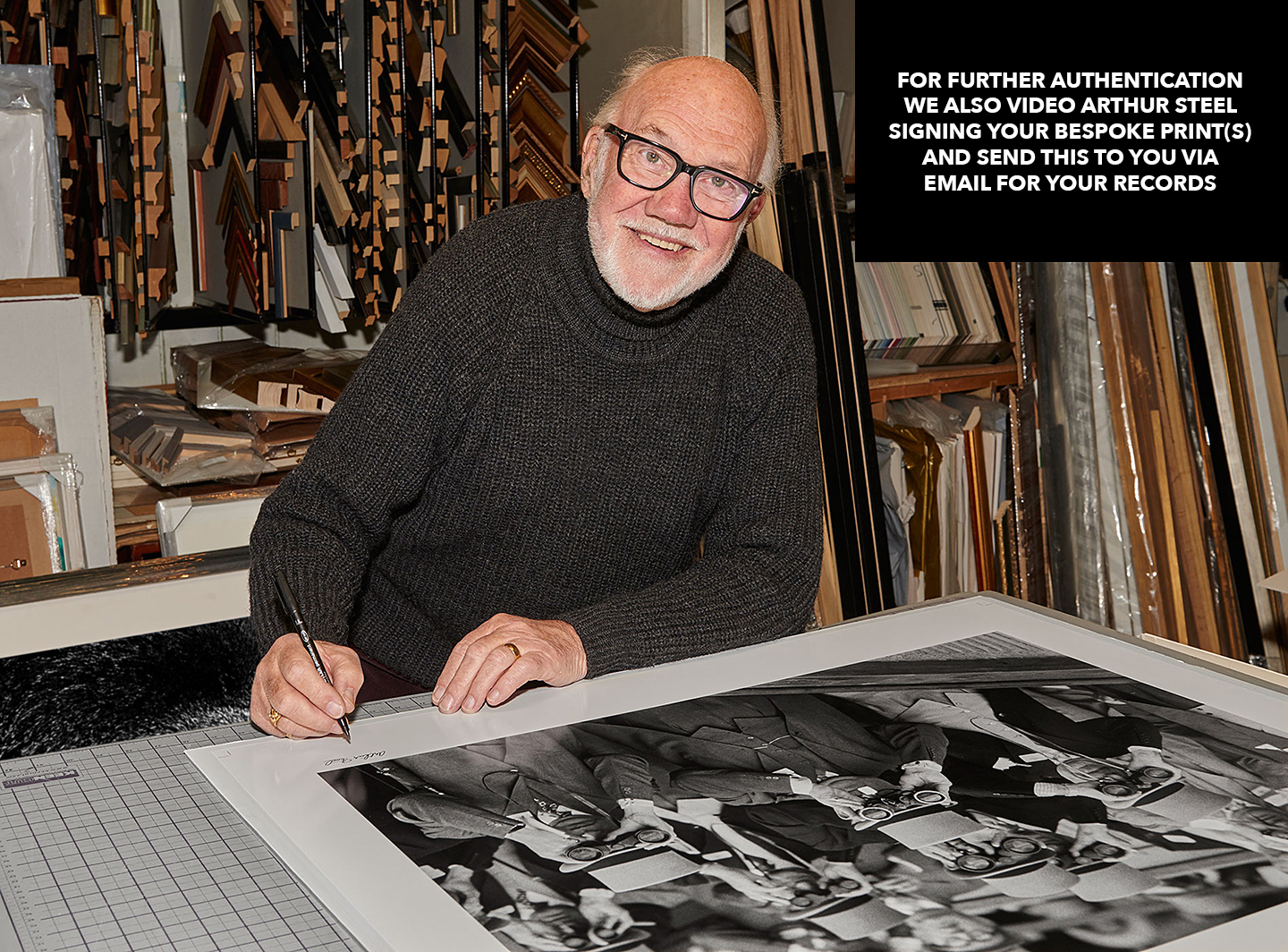Description
An exclusive limited edition photograph of Louis Armstrong by Photojournalist Arthur Steel.
Louis Armstrong practices his scales exclusively for Arthur Steel’s camera whilst awaiting a flight back to his home in the United States of America.
Arthur recalls: “Heathrow’s press officer led me to the departure lounge where Louis and his wife were seated. Their luggage, including his trumpets, were already checked in and so initially I was a little lost as to what I could do to create a good shot. I put the idea to him that if he pretended to play the trumpet it might make a winning picture, luckily for me he cheerfully agreed. I only took two frames and just knew that I had a magical shot in the bag. A short while later the couple were boarding the plane and they kindly gave me a wonderful farewell wave picture too.”
✓ Exceptionally rare limited edition photograph.
✓ Direct from the Artist.
✓ Non licensable images.
✓ Printed by Metro Imaging.
✓ Hand signed by Arthur Steel.
✓ Video of Arthur Steel signing your print(s).
✓ Certificate of Authenticity.
✓ Free worldwide delivery.
✓ Tracked & signed for delivery.
✓ Paypal Pro protection.
✓ Secure SSL payment protection.
✓ 14 day money back guarantee.
✓ Excellent customer care and service.
Black & White Film Grain:
Arthur’s photographs were all captured on 35mm film, a fast medium grain film called ‘Kodak Tri-x Pan’ with an ISO speed of 400. It enabled photojournalists at the time to shoot in relatively low light conditions. Nowadays, we are used to grainless images even at an iso of 800 and above. The grain effect adds to the character and charm of the images and dates the pieces accordingly. Arthur’s images cannot to be compared to todays grainless digital technology.
Signed prints Vs. Unsigned prints:
Most artists sign their prints at the bottom right corner of the piece. By signing a print, the artist approves it, and, claims it as his or her own work. Signatures count for a lot on the print market since they add to the artwork’s authenticity. The value of a signed print is higher than the value of an unsigned print, so if you have a choice, it’s always better to acquire signed prints.
Limited editions Vs. Open editions:
As a rule limited edition prints are valued more highly and therefore are priced higher than the readily available open edition prints. Also, limited edition prints are collectible, which is not the case for open edition prints. Due to their scarcity, limited edition prints are prized, and collectors and art lovers will seek to create a collection of the same.
Camera: Leica 35mm.
Film stock: Kodak Tri-X Pan.
Location: Heathrow Airport, London.
Year: 1968.
Collection: Platinum.
Print Type: Fibre-based Harman Galerie FB Digital.
Printed by: Metro Imaging.
Limited Editions:
All prints are limited editions, no further prints are produced once sold.
60″ prints / edition of 5
50″ prints / edition of 10
40″ prints / edition of 20
30″ prints / edition of 30
20″ prints / edition of 30
12″ prints / edition of 30
Bespoke: All prints are bespoke and printed to order.
Presentation: 12 and 20 inch prints are titled, numbered, signed and carefully enfolded in acid free tissue paper, supplied flat in an acid free 4mm 3-ply box for delivery and storage purposes. The boxes are ideal for gift wrapping. The larger 30, 40, 50 and 60 inch prints are also titled, numbered, signed and carefully enfolded in acid free tissue paper and inserted into a rigid 4mm thick protective cardboard tube for delivery.
Optional Dry Mounting for clients within the UK: Professional Dry Mounting of the larger print sizes can be arranged at no extra cost, the print would then be perfectly flat and ready for framing. However, this makes the overall size bulky and too fragile to send overseas. So, if you reside abroad, it is best that we send a rolled print directly to your chosen framer and you entrust them to carry out the works for you. We recommend that you check that your framer is fully insured as we cannot take responsibility for any damages that may occur during the mounting/framing process.
Delivery: Metro Imaging based in Central London use an experienced shipping service to deliver the boxed and rolled prints. Metro take great care in ensuring the print(s) are very well protected and efficiently delivered anywhere in the UK or overseas. Acid free tissue paper protects prints from scratching/creasing. Metro also offer a vast array of delivery options to suit the recipient’s preference.
Certificate of Authenticity: Each print acquired from The Arthur Steel Archive is accompanied by an individually signed Certificate of Authenticity.
Video of Authenticity: Newly printed bespoke prints are further authenticated by way of a short personalised video. Arthur Steel mentions your name on the recording prior to signing. For example, Arthur will say something like: “I’m signing this print of ‘What a Wonderful World’, edition number 2/20 for Mr. Smith in New York.” For your records, the footage is then sent to you via email.
Watermark: Watermarks will not be present on an original print.
Copyright: © Arthur Steel / The Arthur Steel Archive.
Louis Armstrong Quotes:
‘Seems to me it ain’t the world that’s so bad but what we’re doing to it, and all I’m saying is: see what a wonderful world it would be if only we’d give it a chance. Love, baby – love. That’s the secret.’
‘Some of you young folks been saying to me, ‘Hey Pops, what you mean what a wonderful world? How about all them wars all over the place? You call them wonderful? And how about hunger and pollution? They ain’t so wonderful either.’ But how about listening to old Pops for a minute. It seems to me it ain’t the world that’s so bad, but what we’re doing to it, and all I’m saying is see what a wonderful world it would be if only we’d give it a chance. Love, baby, love. That’s the secret. Yeah. If lots more of us loved each other, we’d solve lots more problems. And man, this world would be a gasser.’
‘And I think to myself what a wonderful world. Oh, yeah.’
‘If I don’t practice for a day, I know it. If I don’t practice for two days, the critics know it. And if I don’t practice for three days, the public knows it.’
‘A lotta cats copy the Mona Lisa, but people still line up to see the original.’
Biography: In 1964 Louis Armstrong recorded his biggest selling record “Hello Dolly” (a song that he had forgotten even recording!). The song went to No.1 on the pop chart, making Armstrong (age 63) the oldest person to ever accomplish that feat. Spurred by the unexpected worldwide success Louis was suddenly in demand for every television venue available. A new generation of music buyers were handed a hearty introduction to the King of Jazz, though for many it was a long time before they could hope to grasp his importance. His last big hit, “What a Wonderful World”, didn’t really leave it’s mark until it’s inclusion in the film ‘Good Morning Vietnam’, 16 years after he had passed away.
Arthur Steel photographed Louis Armstrong at London’s Heathrow Airport just before he boarded an Airplane destined for his home, The United States of America. The photograph perfectly encapsulates the heart and soul of Louis Armstrong: Anytime he appeared on film, played on stage, or performed on record, it was, indeed, a wonderful, wonderful world.
Louis Daniel Armstrong (August 4, 1901 – July 6, 1971), nicknamed Satchmo, Satch, and Pops, was an American trumpeter, composer, singer and occasional actor who was one of the most influential figures in jazz. His career spanned five decades, from the 1920s to the 1960s, and different eras in the history of jazz. In 2017, he was inducted into the Rhythm & Blues Hall of Fame.
Armstrong was born and raised in New Orleans. Coming to prominence in the 1920s as an “inventive” trumpet and cornet player, Armstrong was a foundational influence in jazz, shifting the focus of the music from collective improvisation to solo performance. Around 1922, he followed his mentor, Joe “King” Oliver, to Chicago to play in the Creole Jazz Band. In the Windy City, he networked with other jazz musicians, reconnecting with his friend, Bix Biederbecke, and made new contacts, which included Hoagy Carmichael and Lil Hardin. He earned a reputation at “cutting contests”, and moved to New York in order to join Fletcher Henderson’s band.
With his instantly recognisable gravelly voice, Armstrong was also an influential singer, demonstrating great dexterity as an improviser, bending the lyrics and melody of a song for expressive purposes. He was also very skilled at scat singing. Armstrong is renowned for his charismatic stage presence and voice almost as much as for his trumpet playing. Armstrong’s influence extends well beyond jazz, and by the end of his career in the 1960s, he was widely regarded as a profound influence on popular music in general. Armstrong was one of the first truly popular African-American entertainers to “cross over”, whose skin colour was secondary to his music in an America that was extremely racially divided at the time. He rarely publicly politicised his race, often to the dismay of fellow African Americans, but took a well-publicised stand for desegregation in the Little Rock crisis. His artistry and personality allowed him access to the upper echelons of American society, then highly restricted for black men.






Recent Comments